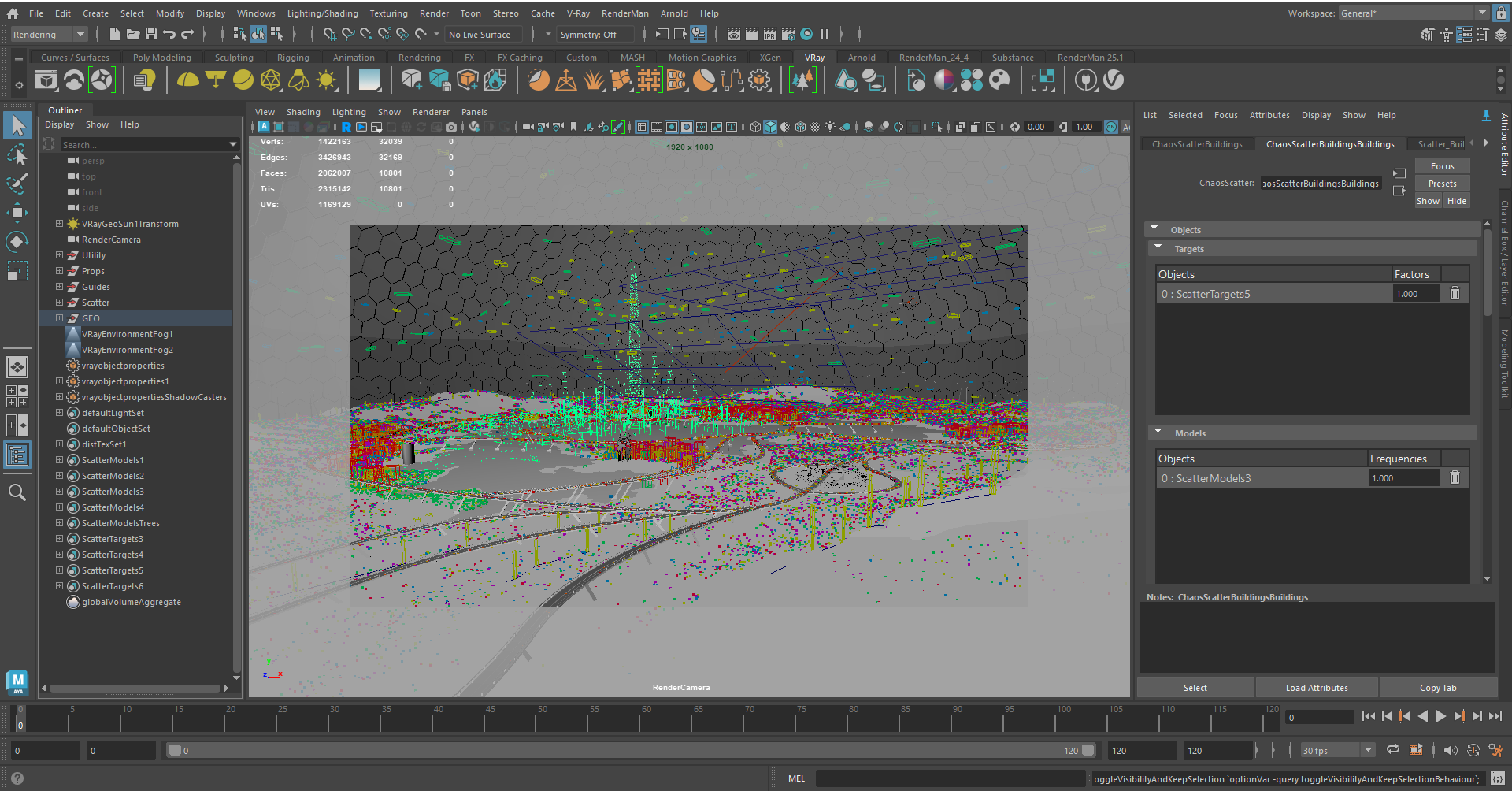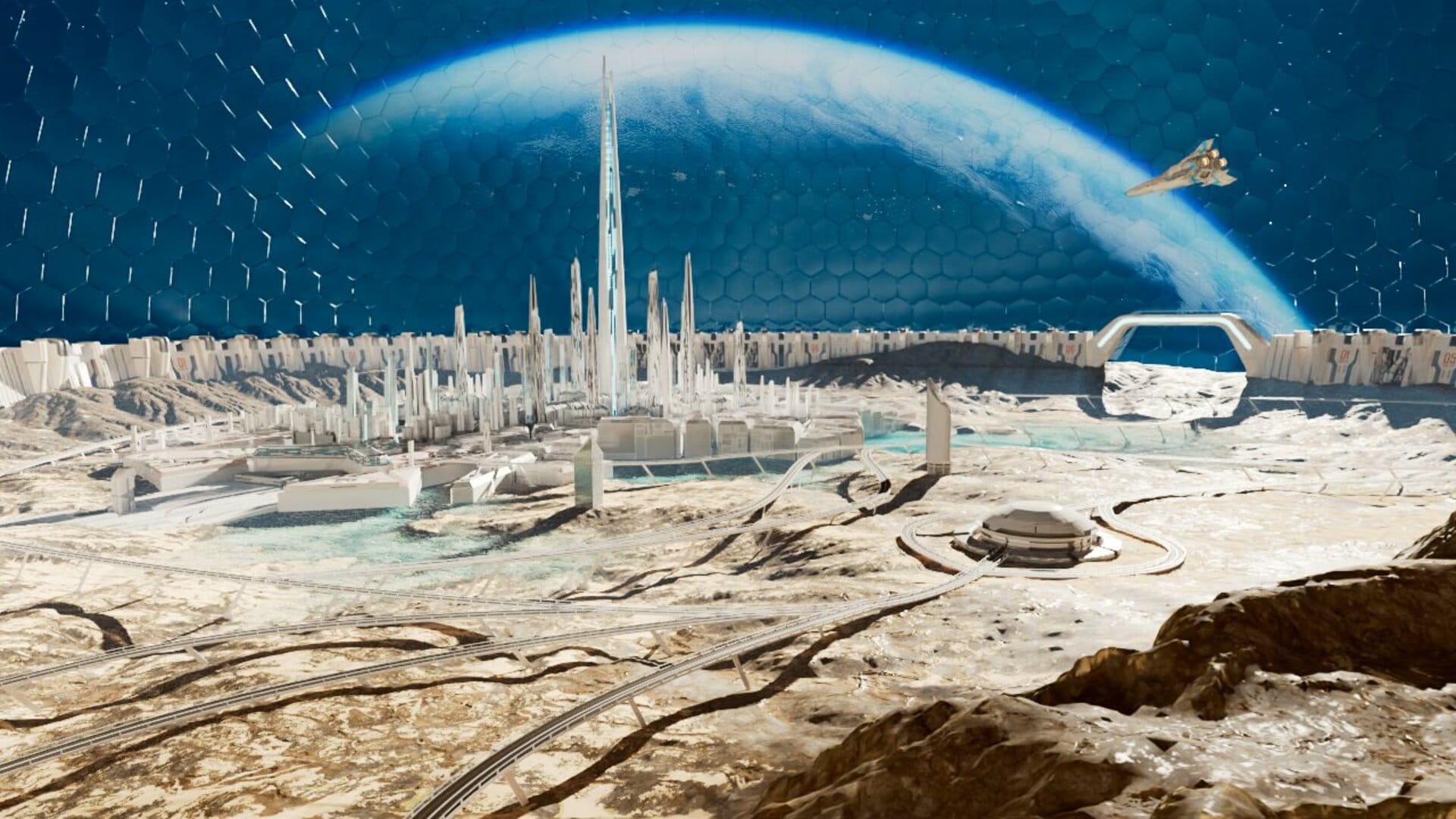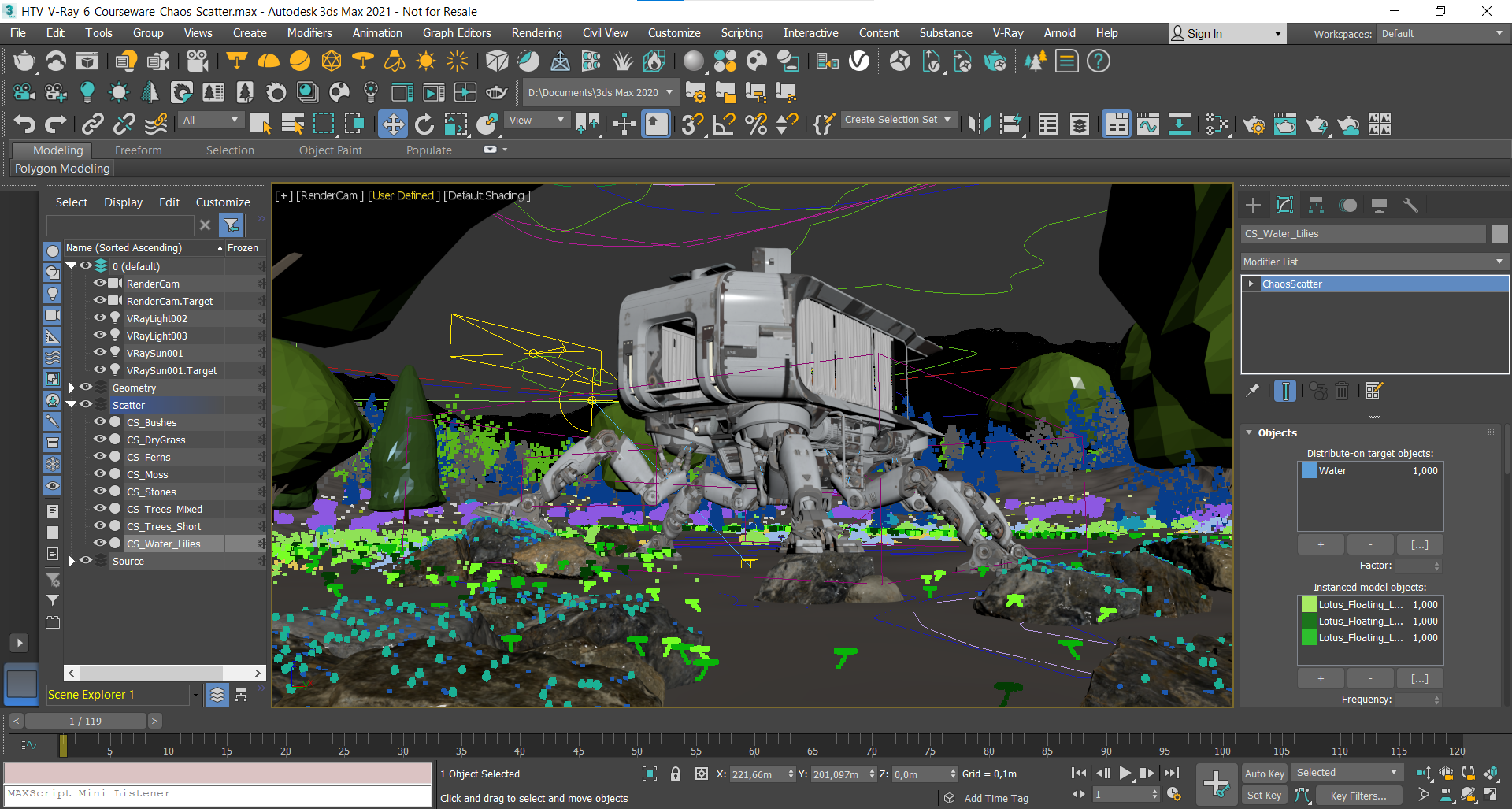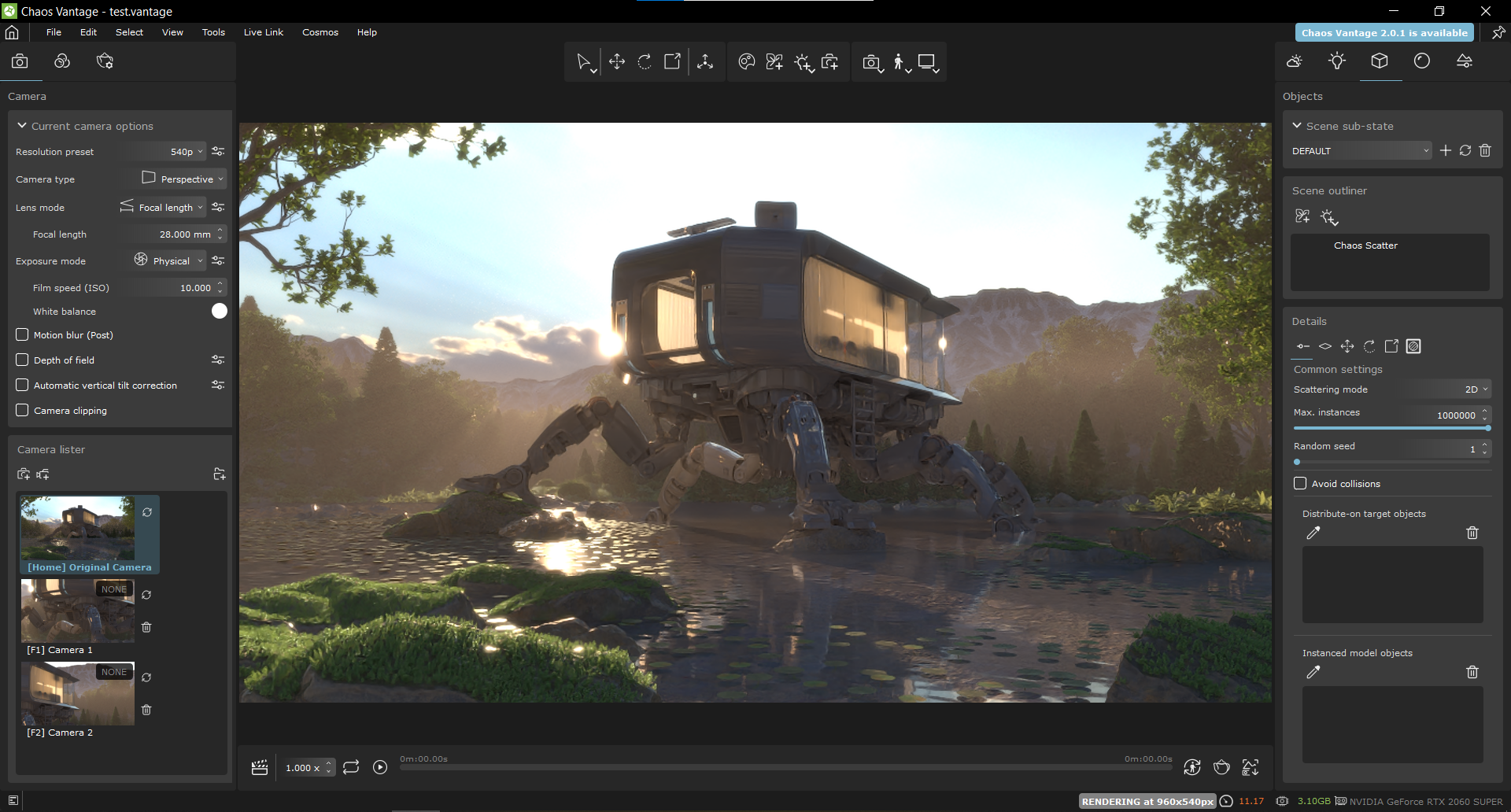V-Ray Product Specialist Petya Georgieva explains how the latest version of Chaos Scatter will make it even easier to populate scenes with multiple objects.
With the release of V-Ray 6, update 1 for Maya and Cinema 4D, Chaos Scatter is now available for every version of V-Ray. This powerful new tool for instancing and distribution now allows more users to quickly populate scenes with many objects for creating captivating projects. We take a step back to look at Chaos Scatter’s development journey, how V-Ray 6.1 takes it on a new course, and what lies ahead.
What is Chaos Scatter?
Chaos Scatter offers an easy-to-use workflow for creating complex environments by procedurally instantiating and distributing millions of objects while still being memory efficient. The scattering modes – Along Curves, On Surfaces, and in Bounding Boxes – combined with numerous customization options allow users to quickly fine-tune their project to fit their creative needs.
Whether it’s a massive jungle environment with thousands of trees, exotic shrubs, and beautiful flowers, a city landscape with many houses, parks, and cars stuck in traffic, or something a bit more fun like an army of gummy bears marching towards their next battle, Chaos Scatter is a tool that can help any project reach its full potential more quickly and easily.
Chaos Scatter is available in Corona for 3ds Max and Cinema 4D, and V-Ray for 3ds Max, SketchUp, Rhino, Revit, Maya, Cinema 4D, and Vantage.



The Story of Chaos Scatter
Chaos Scatter’s journey began in our Czech offices as Corona Scatter. Our goal at Chaos is always to provide more than just a renderer – we help our users simplify their workflows with intuitive tools that go beyond rendering. A task that Corona users often encountered was the need to create vegetation, lawns, or pebbled pathways. Since this was integral for our users, we wanted to include this functionality within the Corona renderer. It soon became apparent that this would be a valuable tool for all of our users, and thus Corona Scatter branched off into its own independent product – Chaos Scatter. Part of its functionality first appeared with V-Ray 5 Update 2 for SketchUp, Rhino, and Revit but its full debut in the V-Ray family came with version 6 for 3ds Max.
After V-Ray 6 for 3ds Max, we began integrating Chaos Scatter with V-Ray for Cinema 4D. Even though users had tools like MoGraph, Chaos Scatter would offer a simpler and faster way to populate outdoor scenes. Likewise, Maya already had many scattering plug-ins available, such as MASH, XGen, Bifrost, etc. We thought that yet another tool wouldn’t be beneficial to users, but after the V-Ray 6 for 3ds Max release, our forums and inboxes were quickly filled up with requests. It became clear that there are many reasons a tool like Chaos Scatter would be more beneficial to our users, and one of our biggest priorities became delivering it within the next update. We realized that there’s also an opportunity to pull expertise and effort from different Chaos teams and make further improvements to Chaos Scatter across all products – more on that later.
The “How?”
Let’s get into the nitty-gritty. The way Chaos Scatter is currently implemented in our V-Ray integrations is that it creates a V-Ray Instancer under the hood. While effective, this means it needs to be fed the original geometry, all its scattered positions, transformations, and other information. Because this process creates a lot of data that needs to be exported and stored, start-up times can be slow and the exported .vrscene files can become very large, which in turn means that uploading to Chaos Cloud for rendering can also be slow.
We took those limitations in mind and set off to resolve them with a Chaos Scatter “procedural”; a V-Ray plugin that procedurally generates the instances based on parameter values. This process uses far less data, resulting in faster export from V-Ray and smaller .vrscene files, which means that rendering starts faster and uploading to the Chaos Cloud takes less time.
However, this also meant the plugin had to be written from scratch, and implementing every single Chaos Scatter feature was not possible for Update 1. We are convinced that this is the right way to move forward, and we are working hard to add what’s missing in the new procedural in time for V-Ray 6, Update 2.
Our development was split in two for Update 1: we stuck with the proven VRayInstancer approach with Cinema 4D, but took the procedural approach with V-Ray for Maya and V-Ray Standalone. For the future, the plan is to move all V-Ray products that include Scatter to using the new procedural, so that faster startup, smaller .vrscene files, and quicker Cloud upload becomes the standard across all our products.
Why should you use Chaos Scatter?
We followed the development journey of Chaos Scatter, but why should you use it? We may be biased when recommending it, but there are some appealing advantages:
- It is included in Corona, V-Ray, and Vantage at no extra charge and without additional downloads.
- Gentle learning curve – our goal is to provide easy-to-use solutions and we believe we have developed a tool that’s intuitive for artists at any level.
- In-house support – it is always guaranteed that everything done with Chaos Scatter will be compatible with V-Ray and the rest of our products. Additionally, any user requests or problem reports come straight to us and can be addressed quickly.
- Many customization options – from its three scattering modes to the multiple transformation options, Chaos Scatter can fit any project’s needs. On top of that, new features and improvements are constantly in the works.
- Speed – the different options allow users to quickly populate scenes any way they like which can speed up their workflows.
- Memory efficiency – efficient use of resources allows artists to create millions of instances without worrying about running out of memory.
- Presets – Chaos Scatter presets from Chaos Cosmos help you jump-start your projects. These are currently available in Corona and V-Ray for Cinema 4D, 3ds Max, and soon to be available in V-Ray for Maya, Sketchup and Rhino.

"I really love the ease of use of Chaos Scatter. It was recently introduced, but we were already able to use it in a few production shots with great success and continue to use it on other more complex projects. Other plugins caused many problems for us – scattering large and dense forest areas was very time-consuming and troublesome. I love the fact that Chaos Scatter just works – it renders really fast, and when we encountered technical challenges in the pre-release version they were quickly resolved by the Chaos team. We’ve already used Chaos Scatter in Superman and Lois season three, and to build a forest scene for SkyMed."
Dmitry Vinnik
Owner and Supervisor, Silhouette Images
How to use Chaos Scatter
To use Chaos Scatter, you need to have V-Ray, Corona, or Vantage. Refer to the documentation for detailed guides to get you started with Chaos Scatter for V-Ray for 3ds Max, Maya, Cinema 4D, SketchUp, Rhino, Revit, Corona for 3ds Max, Cinema 4D, and Vantage. It’s simple: create a Chaos Scatter object and then add geometry for scattering in the Models list and the geometry to scatter onto in the Targets list. You can use meshes, proxies, and VDB caches as your model and target geometries, and currently in development – you can also scatter lights. Based on your project, you can decide the best type of scattering and the appropriate settings and maps.


What lies ahead
Our priority is to add the features that are currently available in the original Chaos Scatter but are missing in the Chaos Scatter procedural and consecutively the V-Ray for Maya integration. These include but are not limited to Areas, Camera Clipping, Instance editing, Cosmos presets, better viewport representation and more. Once the procedural is up to speed, we plan to migrate the rest of our V-Ray integrations to it so the additional benefits can reach all users.
In the meantime, if you are a Maya user and want to stay ahead, you can use the V-Ray for Maya nightly builds where we’ve already added Curve include and exclude lists (Areas), and the ability to instance lights.
In the long run, there are some new Scatter features currently in the works for all integrations. One such example is the ability to “paint” scatter areas live in the 3D scene for a more robust workflow. We also plan to work on clustering and clumping of scatter objects which would help break up or enhance some of the patterning in the scenes. And, of course, we’re working on more Cosmos presets to help kick-start different types of projects. While we’re hard at work developing those, our forums are always open for user suggestions (or demos of finished projects), so don’t feel shy to reach out.
The future of Chaos Scatter looks bright, with new features and improvements being added all the time. It has the potential to revolutionize the way artists work by making it easier than ever to create complex scenes with Chaos products.





